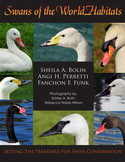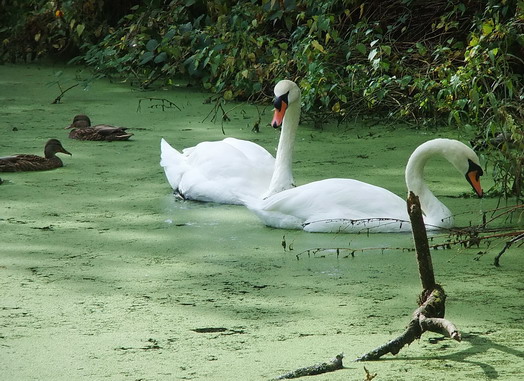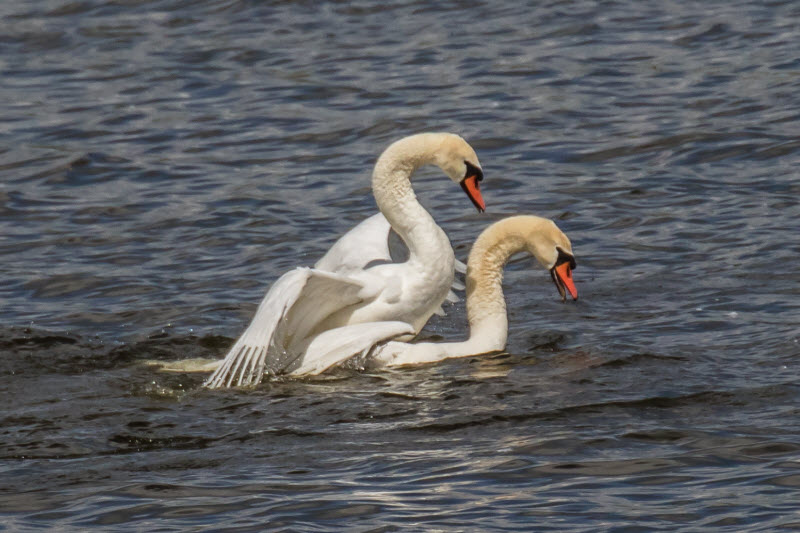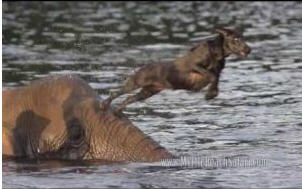Mute Swan Facts
|
|
Sounds | Male-Female |
Mate For Life | Mating | Eggs |
Cygnets |
Food | Pinioning
Lifetime | Population |
Size & Weight | Names | Swan
drowning a Challenger
|
► Intelligence and memory: Swans are highly intelligent and remember who has been kind to them, or not. ► Behavior: Swans respond in kind to gentle and considerate treatment. They don’t arbitrarily attack people, and will only bite if they feel threatened. They are more aggressive during the nesting season because they need to protect their nest, eggs and babies. Nesting season usually starts in March and lasts a few months until the cygnets can launch out on their own. ► Vision and hearing: Mute swans have sharp vision and hearing. ► Sounds: Although they don’t have a “call” they have a remarkable assortment of sounds to convey a broad range of emotions, from a gentle ‘bleat’ through a range of puppy-like barking notes, and a head-to-tail long snort sometimes combined with head-raising and feathers fluffed, to register delight. ► How to recognize a male from a female: Male and female look alike, but if you look carefully, you can tell one from the other: 1- Males are larger than females; 2- The knob at the base of the male's upper bill is larger than the female's knob. By the way, it’s this knob that distinguishes the mute swan from all others; 3- The neck of a male is thicker than the neck of a female. ► Mates for life: Swans usually mate for life, remaining together through the year, but “divorces” have been known, and if one of a pair dies, the survivor usually seeks out a new mate, and the pair remain devoted. (see Precious) ► Mating: Swans begin to breed between 3 and 4 years of age. It’s a special treat to see swan mates “displaying” during the mating season, gracefully touching bill-to-bill and breast-to-breast until a perfect heart shape is formed, or gently intertwining their necks. ► Eggs: They lay from 5 to 10 eggs that take from 35 to 42 days to hatch. The female does most of the egg incubation, but every now and then the male will replace her for a while so she can have a swim and a ‘bite to eat’ in the lagoon. ► Cygnets are usually pale gray with gray legs that turn black as they grow, but there is a European sub-species or variant known as the Polish Mute, where the cygnets are white, with pink legs and feet. Our Mama Swan is the only one on Lost Lagoon. This coloring is due to a recessive gene. ► Food: Swans eat aquatic vegetation and insects, even tiny fish and tadpoles. Because they can plunge their long neck well below the water’s surface, they’re not in competition with ducks and smaller waterfowl for food. They actually help the smaller birds when parts of plants they’re eating float to the surface. ► Pinioning: Following Environment Canada's regulations, the swans of Lost Lagoon have been “pinioned” meaning their wing tendons have been clipped. This is done because the Mute Swan was an introduced species, and not native to British Columbia, Canada. Pinioning ensures that they won’t become feral and intermix with native species. They cannot fly away but can raise themselves above the water surface for speedier movement, or to protect their cygnets. ► Size and weight: Mute swans weigh from 6.5 – 13 kg (14 – 30 pounds), are about 160 cm (5 feet) long and can have a wingspan up to 2.5 meters (8 feet). ► Neck: A mute swan’s neck has 23 vertebrae, more than any other bird. ► Feathers: A swan has some 25,000 feathers ► Lifetime: A swan in a protected environment might live as long as 30 years. For example, as at October 2005, our Boulika is about 25 years old. ► Population: Although the North American Mute Swan population is now around 13,000, there are fewer than 1,000 in Canada, and these are divided between southern Ontario and coastal British Columbia (Source: Canadian Wildlife - Vol. 13, No. 4 - Page 22). ► A male swan is called a "cob" ► A female swan is called a "pen" ► A baby swan is called a "cygnet" ► A group of cygnets or eggs is called a "clutch" ► A group of swans in the wild is called a “herd” while those in captivity are called a “fleet” ► Attempt to drown: Dramatic example (below) of a swan attacking a challenger to his territory: The Attacker is trying to drown the Challenger. Note: These pictures were all taken within a two-minute period.
The Attacker (the one who "owns" the territory) is on top of the Challenger.
Notice how the swan on top pushes the Challenger down a bit further.
Further
down... Notice that they turned 180 degrees towards the shore.
And further down....
At this point, the Challenger is drowning. At
this moment, the photographer - who before
this moment thought that this scene was a mating scene between a male and a
female - was right up to them, and could hear the Challenger making little
mewing sounds like a kitten; he was under water and had almost stopped
moving at all, while the Attacker was beating him with his
wings, holding the Challenger's neck under.
Meanwhile,
the Challenger's mate had been 'way back up the road, on the nest, working
on arranging twigs, sitting quietly by herself (and I suspect the Challenger
was busy pushing up closer to the Attacker's end than was wise for him).
The battle was going on far away from that nest area....about three or four
minutes' walk at least. Somehow, the female heard and before the
photographer knew what was happening, the female appeared and was almost airborne
as she attacked the Attacker full on from the rear, biting and beating at
him with her wings. The Attacker backed off, like he had been shot!
She attacked him again, with feet, wings and bill. He pedaled off in a
hasty retreat, as she circled around and around, all fluffed up like a
warrior-maiden.
The Challenger's female is circling the area after the fight, ready to fight again.
Zoom on the tattered Challenger Meantime....the Challenger sneaked off to the other end of the lagoon. The photographer was really worried about him - keeping an eye on him through her binoculars. The Challenger was trying to preen a number of feathers poking out at weird angles that had been half pulled out. He recovered some of his pride and eventually - very rumpled - swam over to the photographer to get some sympathy. The photographer felt much better on seeing him stand up in the water, snort and flap his shredded wings in an effort at reducing the humiliation of having his female and the photographer rescue him! And the next day, and the day after, he went to the Attacker's territory again, but retreated on time to avoid the same fate. Mating swans look much the same in the first part of their ritual but the male pulls the female's head back so she won't drown.
Photos courtesy of Fiona Sinclair | |
|
|
- NEW: Swans building nest in inappropriate area by: Victoria
- NEW: Grieving behaviour after chased cygnet is killed? by: Maxine
- NEW: Re: Swan flight by: The Regal Swan
- NEW: Grieving behaviour after chased cygnet is killed? by: Maxine
- Wild swans at Lost Lagoon? by: Miki and Fiona
- Fiona and the swans by: Message from Karen
- Royal swan fight by: Just trying to kill each other!
- Fiona and the swans by: Message from Karen
- We’re Walking on Air! by: Fiona
- "Attempted Murder" by: Jørgen Bjerring













 I have just been in Vancouver for a couple of days and just prior to leaving I took a 5 mile stroll around Stanley Park culminating at Lost Lagoon. There I saw Fiona feeding the swans and I have to..
I have just been in Vancouver for a couple of days and just prior to leaving I took a 5 mile stroll around Stanley Park culminating at Lost Lagoon. There I saw Fiona feeding the swans and I have to..
 Having just returned home from a trip to see our former Lost Lagoon swans Tristan, Marika and Bijan in their new location, our happiness cannot be measured. We already knew they were in an ideal..
Having just returned home from a trip to see our former Lost Lagoon swans Tristan, Marika and Bijan in their new location, our happiness cannot be measured. We already knew they were in an ideal..
 Yeasterday - May 22 - I saw two Mute Swans in close contact. During the foreplay the biting was not very aggressive and after a couple of minutes it could look like a mating. But after 15 seconds the..
Yeasterday - May 22 - I saw two Mute Swans in close contact. During the foreplay the biting was not very aggressive and after a couple of minutes it could look like a mating. But after 15 seconds the..
 The relationship of Bubbles and Bella developed because of their shared love of the water. The pursuit of "aquatic antics" instilled a strong bond between these unlikely pals. Watermark on..
The relationship of Bubbles and Bella developed because of their shared love of the water. The pursuit of "aquatic antics" instilled a strong bond between these unlikely pals. Watermark on..

